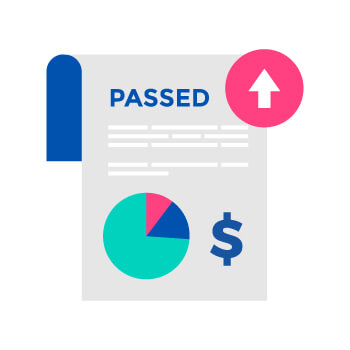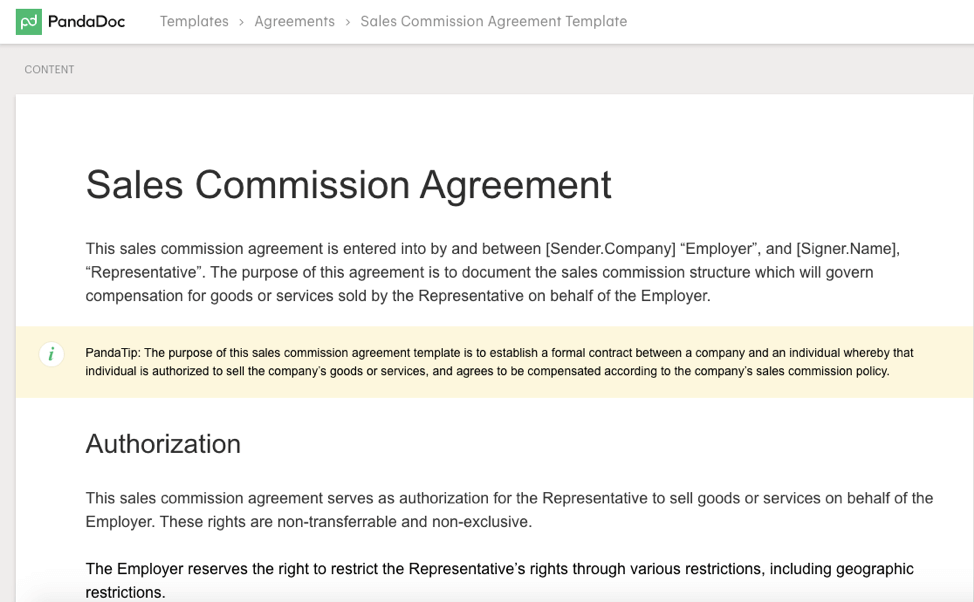7 Sales Commission Structures (& How to Decide What’s Best for Your Team)

Contents
Your company’s commission structure is a critical piece of your sales organization. How you pay your sales reps not only affects your profitability, but can also help you to attract and retain top sales talent.
Studies show that companies paying competitively at the 75th percentile or higher have 50% less sales turnover. In some cases, paying more could end up saving you money in the long term.
Here are some common sales commission options to consider, and how you can choose the one that’s best for your team.
Click here to download our pre-programmed spreadsheet to calculate the total compensation amount for each type of commission structure.
1. 100% Commission
In a straight commission plan, the only income sales reps earn comes directly from their sales.
The biggest positive for sales reps is that it provides the highest earning potential. Most companies don’t put a commission cap on commission plans, so the sky’s the limit for sales reps. Since the company doesn’t have to pay a base salary, they can offer a higher commission on each sale.
This structure puts sales reps in total control of their income, since they can work more hours if they want to make more money. It’s also a way for them to gauge how well they’re doing in the role.
For companies, this structure offers the fastest route to market, which is why this option is desirable for startups.
Commission-only reps are considered independent contractors, so they’re not technically in-house employees. This can save money on hiring, taxes, benefits, and other expenses since companies only pay out when the rep is bringing in revenue.
RELATED: How to Manage a Sales Team
However, greater income potential doesn’t always mean better salespeople or a higher income.
Sales reps assume much more risk with a commission-only structure since they don’t have a base salary to fall back on, so companies that offer 100% commission may experience higher turnover and a smaller applicant pool.
Many salespeople don’t want the income risk and prefer to have the security of a base salary. Unless you have a solid training program that guarantees success, you may have trouble filling and maintaining sales roles.
2. Base Salary + Commission
One of the most common sales commission structures is a base rate plus commission on every sale. Some companies provide an hourly rate as the base, while others stick to a straight salary.
This model puts responsibility on both the company and the sales rep.
The company invests in the rep with a monetary reward, regardless of their performance, in addition to compensation for whatever they sell. In exchange, the sales rep fully invests their skills and time to earn both parts of their compensation.
Typically, the base salary isn’t enough on its own to provide a viable income for the sales rep. Salespeople will still largely rely on their commissions, but at least have a cushion to fall back on as they ramp up production or if there’s a shift in the market that could cause sales to slow down.
The best sales reps are interested in companies that want to invest in their success. Companies that offer a base salary can make sales reps feel confident that they’ll be successful, since companies don’t want to gamble on candidates who won’t be able to produce.
RELATED: 7 Sales Team Motivation Strategies that Cost You Nothing
The model still rewards performance, and since you can control the fixed salary or number of hours the sales rep works, you can predict your expenses and know how much reps need to sell to be profitable.
Ultimately, the customers benefit, too. The sales process retains its integrity since there isn’t as much at stake if the sales rep doesn’t close the deal. This alone removes much of the stress from the process since reps aren’t cutting corners or going off-book just to make a sale.
3. Tiered Commission
Companies that want an easy way to motivate reps and reward top performers may prefer a tiered commission structure. After closing a certain number of deals or reaching certain revenue benchmarks, the salesperson’s commission rate increases.
For example, sales reps may earn a 5% commission on all sales up to $20,000 in revenue. Once they pass this mark, they will earn an 8% commission on all other sales during that same period.
Here is what this looks like in action:

Click here to download the spreadsheet with the above calculations pre-programmed.
Some companies implement a similar model for underperformers that reduces their commissions if they don’t hit their quota. For example, if a sales rep only met 75% of their quota, then they may only get 75% of their intended commission.
The purpose is to motivate salespeople to continue closing deals, even after they reach their goals. It also allows them to get creative with other techniques, such as upselling or cross-selling, to increase their average ticket.
4. Revenue Commission
Whether you choose a commission-only structure or a base salary plus commission, you’ll also need to decide how to set your commission rates.
One popular model is the revenue commission model, which is popular for field sales organizations or companies that sell products with set price points.
For example, if the sales rep sells a $1,000 service, they get 10% in commission.
Many sales organizations use this method when they want to grow their market share or enter new territories. They’re not as focused on profit as they are on larger business goals.
It’s simple to understand and execute for reps and company leaders alike, and paying reps based on the revenue they bring in ensures that top sales performers are also the highest paid.
5. Gross Margin Commission Model
A slight variation on the revenue commission model is the gross margin commission, which takes into account the expenses associated with the products you sell. Rather than earn a percentage on the revenue, sales reps earn a percentage of the profit.
For example, if you sell a product for $1,000 and it has $600 worth of expenses, then the reps would earn a percentage of the remaining $400.
This model ensures that every sales transaction supports the company’s bottom line. For starters, reps who rely on discounting to close deals have less of an incentive to do so, which prevents your profits from eroding.
RELATED: How to Discount Right: Crucial Lessons for Building SaaS Proposals
Their commission is linked directly to the price the customer pays, so they can’t offer a discount without also reducing their own pay.
It can also encourage sales reps to sell the products with the highest profit margins — a win/win for the company and the rep.
6. Commission Draw
The commission draw model contains elements of the commission-only and the base pay plus commission structures.
Simply put, each sales rep receives some amount of guaranteed pay each month, regardless of how much they sell. If they earn less in commissions than the draw amount, they’ll keep their commission in addition to the difference between the draw amount and the commission.
For example, if a sales rep is eligible for a $2,000 draw and they earn $1,700 in commission, they keep the full amount of the commission plus $300 (draw amount minus commission).
Most notably, these are advanced payments and must be paid back.
This system is typically used for new hires who need time to ramp up production. Studies show the average sales rep takes about 9.1 months to gain full productivity, so having a draw allowance can provide some assurance during this time.
On the downside, the commission draw model can be complex to execute, and it’s complicated for sales reps to track and predict their earnings. Worse, if they have several bad sales cycles in a row, they could end up in significant debt to the company.
These can be a bit challenging to calculate, so we created a spreadsheet with the formulas pre-programmed, where you can enter your sales and commission rates and get back the compensation amount. Click here to download that.
7. Base Rate Only
A base rate only model isn’t used very often in modern sales organizations. Rather than offer commissions on every sale, salespeople are paid a flat hourly rate or salary.
There’s no incentive to sell more, so there’s nothing to encourage productivity or motivate your team members unless you offer bonuses or other rewards.
It also fails to allow top performers to stand out. If you’re paying each salesperson the same salary, then your hardest working sales rep is making the same as your lowest performer.
However, some sales organizations use this model if they’re focused solely on inbound leads rather than chasing deals. Your sales reps are spending more time consulting or supporting than “selling.” Their effectiveness relies on their ability to answer questions rather than overcome objections, follow up with leads, and deliver pitches.
Choosing Your Sales Compensation Model
The best sales commission plan is the one that will drive your salespeople to perform their best. But it’s not a black-and-white decision, and many companies often end up with a hybrid of the commission structures discussed above.
Here’s how you can decide which method is ideal for your organization:
Consider Your Current Sales Ecosystem
Start by dialing in on your sales process and current employees.
How much are your top salespeople earning versus your lowest producers? If there’s not much difference, you may need a better way to reward performance.
Do you have a high turnover rate, or are your top performers leaving for a higher paying sales job? If so, you might not be providing enough monetary incentive (especially if you’re currently using a commission-only model).
Are your team members who hit their quotas as productive at the end of the month as they are at the beginning? If not, you might consider a tiered commission model that encourages ongoing sales productivity for greater reward.
Plug in real numbers using each model you’re considering and look at the outcome.
- Does the compensation seem fair?
- Is it easy for the sales rep to track and understand?
- Does the commission structure allow you to remain profitable?
- Will you gain a competitive advantage in your industry that will attract top sales talent?
Most importantly, remember that it’s not just about the dollar amount you pay your employees. Sales leaders should also be able to use your commission structure to motivate their teams, drive performance, and achieve your organizational goals.
Remember, Money Determines Behaviors
One of the biggest considerations when outlining your sales commission structure is how money drives behavior. Your commission model should support company objectives so that sales reps are clear on what their priorities should be.
For example, if you want your sales reps to sell more of Product A because there’s more profit in it for the company, then it might make sense to pay them more for selling Product A.
Build your commission plan around company goals, and design it to overcome existing and potential challenges that could prevent your team from achieving those goals.
Average Sales Commission Rates by Industry
Of course, when it comes to deciding which sales commission structure will work best for you and your team, it’s essential to look at your industry’s average sales commission rates.
Shooting too low when it comes to commission is bound to discourage ambitious sales reps from working for your company. On the other hand, offering higher commission than your rivals will likely attract top talent, with 43% of workers willing to leave their companies for a 10% salary increase.
Yet going too high could be a waste of money: you could get the same results for less.
Seeking some benchmarking? Research from Hubspot dug up the following average commission rates by industry:
- Wholesale and Manufacturing Sales Representatives: $61,660
- Insurance Sales Agents: $50,600
- Advertising Sales Agents: $51,740
- Real Estate Brokers and Sales Agents: $50,300
- Securities, Commodities, and Financial Services Sales Agents: $64,120
- Door-to-Door Sales Workers, News and Street Vendors, and Related Workers: $26,430
- Sales and Related Workers, All Other: $33,220
So, What Is the Typical Sales Commission Percentage?
If only it were so straightforward.
Breaking this down as simply as possible, the average salary to commission ratio in US sales forces is 60:40.
But this is without taking into account different types of sales commission structures or how rates vary by industry.
In more aggressive sales sectors that use independent contractors – such as insurance – you’re more likely to see a 100% commission pay structure, with no base salary to balance it out.
Meanwhile, industries that focus more on customer education, like pharmaceuticals, tend to have a less aggressive mix, such as a 75:25 salary-commission ratio.
Sales leaders also sometimes use different commission structures to motivate different team members in different ways. For instance, those in customer acquisition are likely to see a higher percentage of their total pay come from commission than salespeople working in account management.
For customer acquisition salespeople, this approach puts the onus on hunting for new customers, while account management salespeople are rewarded for cultivating strong relationships with existing customers.
Sales Commission Structure Template
When you’re hiring a new employee who is going to be paid – whether in full or in part – by commission, it’s vital to get your agreement in writing.
You and your new employee must sign a document that details each party’s rights and obligations.
If you don’t have a company lawyer on hand, there are a number of sales commission structure templates available online that make sure you dot the i’s and cross the t’s.
One of my favorites is this Sales Commission Agreement from PandaDoc. This template is perfectly customizable to meet your specific needs and can also be signed by the relevant parties. Bonus: you can also track views and opens on this template.
Alternatively, thisFree Commission Agreement from RocketLawyer automatically customizes the template to the state you’re operating from. The RocketLawyer tool takes you through each step of customization.

There’s also this simple yet effective Commission Agreement from SEQ LEGAL, based on three key cornerstones:
- The “trigger event” which has given rise to the payment obligation
- The base amount
- The commission
Final Thoughts
Outlining your commission structure is one of the most important things you’ll do in your sales organization. There’s no single best solution for every organization, and sometimes, finding the right balance comes down to old fashioned trial-and-error.
It’s okay to experiment with different solutions to see what works. Your sales organization will likely experience its share of turnover, and what motivates one team to perform might fail to motivate the team you have 10 years from now.
The best practice is to focus on an effective sales process first.
When your reps are able to sell confidently and predict and repeat their success, creating a fair sales commission structure will be much easier.





